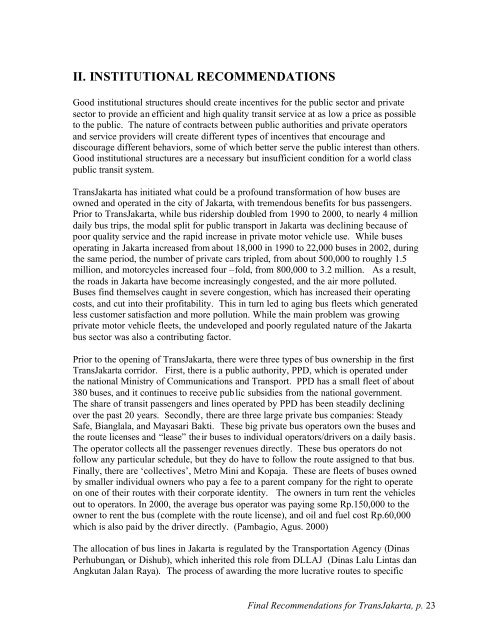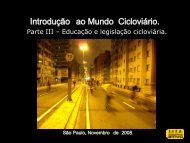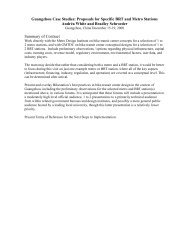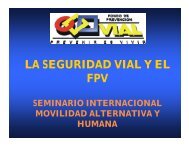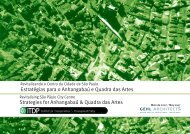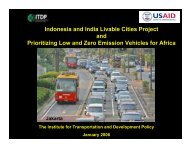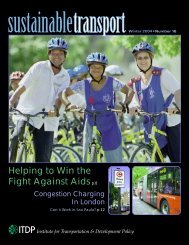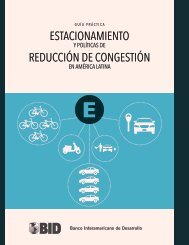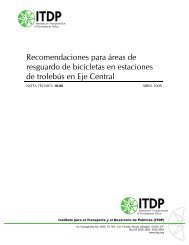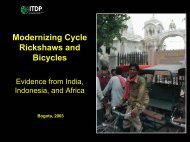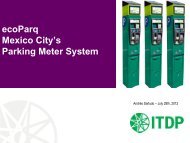Making TransJakarta a World Class BRT System - ITDP | Institute for ...
Making TransJakarta a World Class BRT System - ITDP | Institute for ...
Making TransJakarta a World Class BRT System - ITDP | Institute for ...
You also want an ePaper? Increase the reach of your titles
YUMPU automatically turns print PDFs into web optimized ePapers that Google loves.
II. INSTITUTIONAL RECOMMENDATIONS<br />
Good institutional structures should create incentives <strong>for</strong> the public sector and private<br />
sector to provide an efficient and high quality transit service at as low a price as possible<br />
to the public. The nature of contracts between public authorities and private operators<br />
and service providers will create different types of incentives that encourage and<br />
discourage different behaviors, some of which better serve the public interest than others.<br />
Good institutional structures are a necessary but insufficient condition <strong>for</strong> a world class<br />
public transit system.<br />
<strong>TransJakarta</strong> has initiated what could be a profound trans<strong>for</strong>mation of how buses are<br />
owned and operated in the city of Jakarta, with tremendous benefits <strong>for</strong> bus passengers.<br />
Prior to <strong>TransJakarta</strong>, while bus ridership doubled from 1990 to 2000, to nearly 4 million<br />
daily bus trips, the modal split <strong>for</strong> public transport in Jakarta was declining because of<br />
poor quality service and the rapid increase in private motor vehicle use. While buses<br />
operating in Jakarta increased from about 18,000 in 1990 to 22,000 buses in 2002, during<br />
the same period, the number of private cars tripled, from about 500,000 to roughly 1.5<br />
million, and motorcycles increased four –fold, from 800,000 to 3.2 million. As a result,<br />
the roads in Jakarta have become increasingly congested, and the air more polluted.<br />
Buses find themselves caught in severe congestion, which has increased their operating<br />
costs, and cut into their profitability. This in turn led to aging bus fleets which generated<br />
less customer satisfaction and more pollution. While the main problem was growing<br />
private motor vehicle fleets, the undeveloped and poorly regulated nature of the Jakarta<br />
bus sector was also a contributing factor.<br />
Prior to the opening of <strong>TransJakarta</strong>, there were three types of bus ownership in the first<br />
<strong>TransJakarta</strong> corridor. First, there is a public authority, PPD, which is operated under<br />
the national Ministry of Communications and Transport. PPD has a small fleet of about<br />
380 buses, and it continues to receive public subsidies from the national government.<br />
The share of transit passengers and lines operated by PPD has been steadily declining<br />
over the past 20 years. Secondly, there are three large private bus companies: Steady<br />
Safe, Bianglala, and Mayasari Bakti. These big private bus operators own the buses and<br />
the route licenses and “lease” their buses to individual operators/drivers on a daily basis.<br />
The operator collects all the passenger revenues directly. These bus operators do not<br />
follow any particular schedule, but they do have to follow the route assigned to that bus.<br />
Finally, there are ‘collectives’, Metro Mini and Kopaja. These are fleets of buses owned<br />
by smaller individual owners who pay a fee to a parent company <strong>for</strong> the right to operate<br />
on one of their routes with their corporate identity. The owners in turn rent the vehicles<br />
out to operators. In 2000, the average bus operator was paying some Rp.150,000 to the<br />
owner to rent the bus (complete with the route license), and oil and fuel cost Rp.60,000<br />
which is also paid by the driver directly. (Pambagio, Agus. 2000)<br />
The allocation of bus lines in Jakarta is regulated by the Transportation Agency (Dinas<br />
Perhubungan, or Dishub), which inherited this role from DLLAJ (Dinas Lalu Lintas dan<br />
Angkutan Jalan Raya). The process of awarding the more lucrative routes to specific<br />
Final Recommendations <strong>for</strong> <strong>TransJakarta</strong>, p. 23


